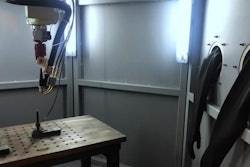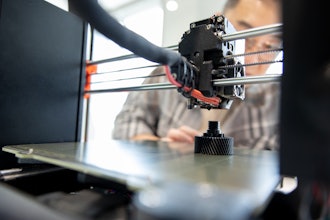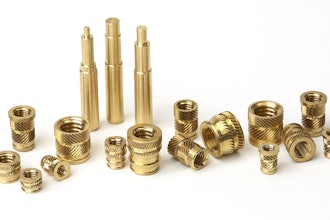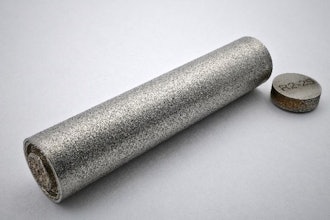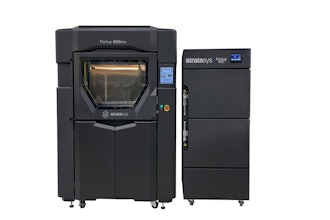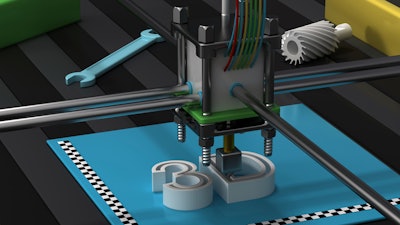
2020 was a painful, unprecedented year that none of us will soon forget.
But 2021 should be significantly brighter. I'm also proud to say that the additive manufacturing industry truly rose to the challenges of the past year. During the COVID-19 pandemic, the industry proved it can step in to make quantities of supplies at scale to keep assembly lines moving. When face masks and other personal protective equipment were in short supply, at Essentium, we were able to quickly produce tens of thousands of 3D-printed protective facemask frames at scale.
And Essentium wasn't alone. The National Institute of Health partnered with America Makes on a physician-reviewed digital repository, allowing anyone to upload a 3D printed medical device design.
Matterhackers worked with their customer base of more than 14,000 consumer-level 3D printers on which more than 70,000 such protective devices were printed. Scott Evans led a multi-agency pursuit through the University of Texas at Austin to develop 3D Scan-to-3D Print fully custom, respirator-type face masks targeting enhanced protections for healthcare workers in ICU settings.
In perhaps the strongest example of an inter-agency, community-engaged response, Texas Governor Gregg Abbott tapped the Texas Military Department and the Texas National Guard to deploy additive manufacturing, medical, logistics, conventional manufacturing, packaging, and procurement professionals to address sagging supply chains and create entirely new value chains – amidst the initial waves of the pandemic.
Heroes all, and I'm delighted to shed light on how the additive manufacturing community leaned forward into the challenge and worked to address critical shortfalls. The promise of additive manufacturing has always been tremendous. But it's not just a promise anymore—now the capability is a reality. Here are five trends that will push 3D printing to greater success in the coming year.
1: Broader Applications
The question has always been: how do you use this technology to cost-effectively create not just one or two items but hundreds or thousands? Well, manufacturing companies have finally cracked the code, and there will be no turning back.
Essentium recently completed the third installment in our annual additive manufacturing industrial survey, conducted by Dimensional Research. We found that the number of companies now using additive manufacturing for full-scale production runs of hundreds of thousands of parts doubled from seven percent in 2019 to 14 percent in 2020. And we expect that percentage to grow even larger next year.
This shift demonstrates that additive manufacturing has evolved from the prototyping phase to the production phase. Our study revealed that 41 percent of companies using 3D printing are doing so for the full-scale production of parts and this number is set to increase to 49 percent in the near term. Said another way: nearly half of additive manufacturing users we surveyed are using the technology in production.
2: Companies Working Smarter, Not Harder
The companies that perform the best in 2021 will learn to embrace the concept of working smarter, not harder. In reality, companies will have to do both. But one example of how companies can work smarter is by shifting the way they acquire capital equipment. Specifically, instead of relying predominantly on a CAPEX expenditure model for expensive machinery, I think it will be incumbent on companies to start leasing that equipment so they can invest in new capabilities with a lower overall risk profile.
Why? Because we are still working our way through a COVID-19-induced recession and for many companies, the capital expenditure process will remain a significant challenge. But if companies—and their procurement organizations—can embrace the idea of leasing equipment like industrial 3D printers, they will ultimately win.
3: Aerospace
The aerospace industry will see a dramatic comeback in 2021. As the airline business as whole recovers, additive manufacturing will also take flight with the industry. The value proposition is clear. Hundreds of airline parts can be manufactured on an industrial 3D printer in the same time it takes to assemble the components by traditional methods. Our recent announcement of longitudinal work with the USAF to certify 2X-3X more new materials in the coming years signifies the shift is accelerating.
4: More 3D Printing Companies Going Public
In 2020, Desktop Metal made headlines when it announced its plan to go public via a deal with blank check company Trine Acquisition Corp. With a targeted valuation of about $2.5 billion and cash goals at the IPO of over $500M, Desktop will have the war chest it needs for further expansion.
I expect other prominent 3D printing companies to follow suit. And that's a good thing. A new crop of publicly traded companies in this space can help raise the additive manufacturing industry profile as a whole.
5: Additive Can Power a New Supply Chain
COVID-19 dramatically accelerated the transition to digital services across multiple sectors and industries. Manufacturing is one of those industries. As borders closed down to prevent the spread of the virus, global supply chains were suddenly at risk as the resultant constriction in the free flow of goods and services also withered. That's when many companies realized that 3D manufacturing could enable them to shift from sourcing parts from remote locations – potentially across the Pacific – to on-site production facilities much closer to the point of use.
Heading into 2021, many companies realize that producing parts themselves, without relying on global suppliers, puts them in a stronger position to get their products to market. Outdated cost disparities, underpinning the optimization for global trans-pacific supply chain structures stood up over the past twenty years, simply no longer support the macroeconomic disruptions and geopolitical uncertainties comprising the nature of the commercial battlespace in 2021 and beyond.
Our survey found that 57 percent of manufacturers increased 3D printing of production parts to keep their supply chains flowing during the crisis. Investments like this don't make sense to unwind. Additionally, 3D printing investment plans have changed at many companies, with 25 percent of manufacturers ramping up 3D printing to meet supply chain needs and 30 percent evaluating industrial-scale 3D printing to fill supply chain gaps.
The bottom line is additive manufacturing is demonstrating its sterling relevance to actual manufacturing. 3D printing is ready for prime time. The manufacturing industry will save billions of dollars in production costs while building stronger businesses that can withstand even a once-in-a-century crisis like the COVID-19 pandemic.
Though much remains uncertain about the timing and up-slope of the eventual business turn, one fact no longer in doubt is whether or not additive manufacturing investments deserve a central feature in the execution strategies companies endeavoring to out-perform their peers. Join me in moving forward, through this turn, into a leaner, more agile future enabled by additive manufacturing.




